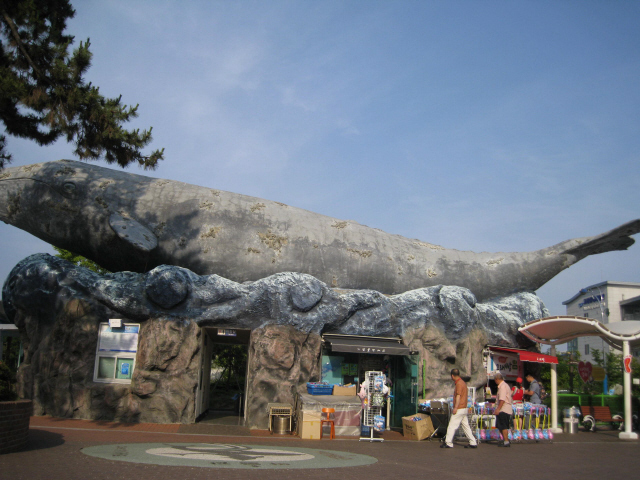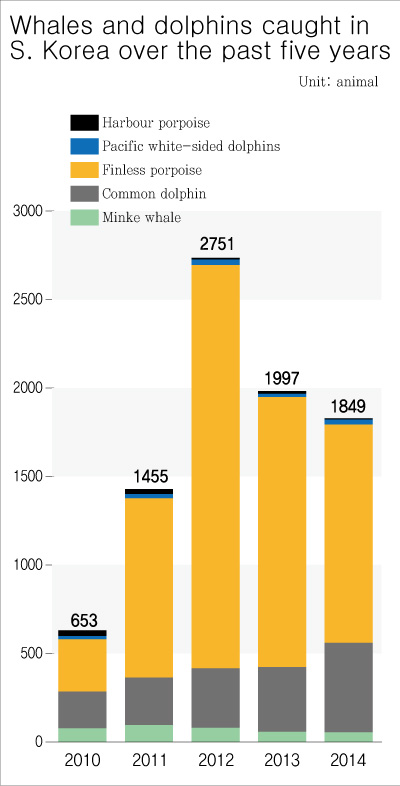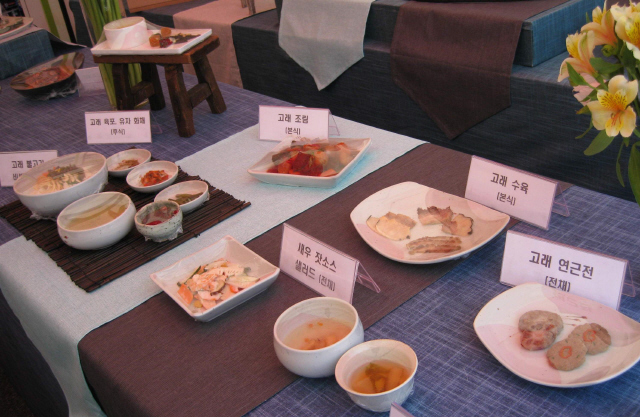[Special report] Amid ban, a quasi-legal boom in whale meat and culture
한겨레신문 Hankyore Daily Posted on : Jul.3,2015 17:10
 |
|
A symbolic monument of a Korean gray whale, which has a Korean name, gwisin gorae, that translates as “ghost whale,” in Ulsan’s Whale Square at Jangsaengpo Port. |
Ulsan designates an area for whale-related tourism, and an industry grows as whale species edge toward oblivion
Roy Chapman Andrews (1884-1960), the US archeologist and adventurer who reportedly served as the model for Indiana Jones, visited the port of Jangsaengpo, Ulsan, to observe whales during the Japanese occupation year of 1912. It was through his academic reports that the world first came to know of the Korean gray whale. The animal, which has a Korean name gwisin gorae that translates as “ghost whale,” disappeared like a ghost from Korean waters around 1977. Today, only the name “Gray Whale Migration Site” (Natural Monument No. 126) remains as a sign where it once was found.
Whale restaurants return to Jangsaengpo in force
 |
|
Whales and dolphins caught in S. Korea over the past five years |
Located in Ulsan’s South district, the port of Jangsaengpo is a forward base for South Korean whaling. The practice began in 1889 when the Korean Empire joined with Russia to establish whaling bases. Up until the International Whaling Commission (IWC) ban on commercial whaling to protect endangered species in 1986, the port was so profitable that dogs were said to “go around with ten thousand won bills in their teeth.” The whaling suspension ushered in a dramatic decline in the village’s fortunes; the population dwindled from over 10,000 to just 1,000 during the 1990s. The port’s identity as a whaling village was only sustained by three or four restaurants that sold meat from whales that were accidentally caught in nets and were sold at auction.
It was in the late ’00s that it began to experience a whale-driven comeback. The government’s enactment of the Act on Special Regional Development in July 2008, designated a 1.62 million square-meter area of Jangsaengpo as the country’s sole “whale cultural district.” Between 2005 and 2009, the district became home to a whale museum, a National Fisheries Research & Development Institute (NFRDI) whale research center, a whale ecosystem activity center, and even seagoing whale tour boats, which in turn brought tourists to the port. This May saw the opening of a whaling culture village, which recreated the area’s old whaling center; a 150-meter-tall whale lighthouse hotel is scheduled for future construction.
“We get over 600,000 tourists a year to the whale museum and ecological center, and 660,000 people came to Jangsaengpo for this year’s whale festival,” said Lee Jae-seok, head of the South district’s whale tourism division.
“The number of residents dropped after the whaling suspension, but it’s since reached about 1,300,” Lee added.
Is the whale festival a problem?
The rising tourist numbers have also meant a rise in restaurants serving whale meat.
“We’ve got more than 20 places now that just sell whale meat,” said a Jangsaengpo resident surnamed Jang. “If you add in the places that sell whale meat along with other things, the number comes out to over seventy.”
So how can the number of whale meat restaurants go up when whaling is banned?
In accordance with the International Convention for the Regulation of Whaling, South Korea’s Fisheries Act makes the deliberate killing of whales a crime punishable by up to three years in prison and fines of up to 30 million won (US$26,800). But the Coast Guard Station does issue whaling sales certificates and allow the sale of meat from incidental catches: whales that are caught in nets designed to capture other types of fish.
Because of this, Jangsaengpo and other parts of Ulsan have been able to profit from selling limited amounts of whale meat even after the ban. The port’s designation as a whale culture district and the growing numbers of tourists visiting the Ulsan Whale Festival held in Jangsaengpo every year since 1995 have meant a boom for the area’s whale meat restaurants.
While monitoring the festival in late May, the Ulsan Federation for Environmental Movement observed the festival’s organizer, Ulsan’s South District, opening a “whale dinner” publicity center where “twelve flavors of whale meat” were advertised, along with whale meat in boiled, spiced, and jerky varieties and the sale of whale meat by “whale culture” groups.
“Whale meat was being sold at the festival venue where people could easily find it, and there was inevitably going to be an increase in consumption, either because people liked it or out of curiosity,” said Jang-Kim Mi-na, one of the participants in the monitoring.
“To meet demand like that, people are going to catch whales to make up for the difference from accidental catches, even if they risk breaking the law,” Jang-Kim said.
Lee Jae-seok, head of the district’s whale tourism division, said the focus of the “whale dinner” publicity was on “foods based around things that whales eat like anchovies and mackerel, not whale meat itself.”
Around the time of this year’s whale festival, the Ulsan Coast Guard Station stopped 14 crew members on two boats, and arrested five, on suspicion of illegal whaling. In total, they are confirmed to have caught ten minke whales and around 20 dolphins between Nov. 2014 and Apr. 2015.
“Illegal whaling tends to go up before the whale festival,” said Yun Seong-gi, head of the Ulsan Coast Guard’s maritime investigation intelligence division. “There are probably around ten fishing boats in Ulsan alone that specialize in whaling, with boats that have been renovated to make it easier to throw harpoons.”
With a single minke whale selling for anywhere from tens to hundreds of thousands of dollars, the demand has remained constant, while weak punishments make the illegal practice difficult to stop.
“When a whale is caught, they take it apart where they are, and then they hide the carcass and the whaling equipment in the water and put up a buoy, so it’s tough to catch them in the act,” Yun explained.
“Even if they are arrested, they often get a suspended sentence after two to three months for a first offense,” he added. “In cases of repeat offenses, they’re released after a year or so and go right back to whaling again.”
 |
|
Twelve flavors of whale meat on display in promotional pavilion at the Ulsan Whale Festival held in Jangsaengpo. |
How to view incidental catches?
“The policy of allowing sale of whales caught incidentally may be encouraging illegal whaling,” argued Ulsan Environmental Education Institute director Oh Yeong-ae recently, suggesting illegally caught whales may be being presented as incidental catches. Speaking at a May 27 conference on whales organized by the University of Ulsan Whale Research Institute and the Korea Institute of Whale Culture, Oh noted that 87% of “incidental” catches from documents reported to the IWC in 2015 were in South Korea and Japan.
“The problem is a combination of a lax system that relies on naked-eye observation and metal detectors to make a judgment on whether the catch was incidental, and permissions on the sale of whales caught accidentally,” Oh continued.
“What we need is to develop a monitoring system and gear that lets us make a strict determination on whether the catch was intentional and prevent it, and to stop the sale of whale meat.”
An Du-hae, head of the NFRDI’s Cetacean Research Institute, noted that legal regulations do require rescue and recovery measures for whales that are caught incidentally, beached, or otherwise adrift.
“But fishermen who try to rescue incidentally caught whales face damages to their nets and gear, and they may be subject to steep fines if they leave a whale caught in a net to die,” An explained. “Under the circumstances, you can’t really expect it to work effectively.”
“In countries like the US and Australia that oppose whaling, they simply shut down the sites where incidental catches happen as a measure to protect the whales,” he added.
According to An, most of the larger species like right whales and gray whales have disappeared from South Korean waters.
“Pretty soon, even the minke whales will be hard to find,” he added.
In contrast, Lee Jae-seok argued that the sale of incidental catches “should not be blocked when countries like Japan and Norway continue to sell whale meat for national profit.”
Chong Ui-pil, head of the University of Ulsan Whale Research Institute, offered a similar position, arguing that whales “occupying a peak position in the oceanic ecosystem food chain and require suitable population adjustments based on scientific research.”
Ju Bong-hyeon, head of the Korea Institute of Whale Culture, said whale meat is “part of long tradition of cuisine, as witnessed in the whaling scenes from the Neolithic rock carvings at Ulsan’s Bangudae terrace.”
But both Chong and Ju also stressed that the focus of the Jangsaengpo whale festival and culture district should be on developing different forms of whale-friendly culture and tourism rather than whale-based cuisine.
“The Jangsaengpo whale culture district is well equipped with hardware infrastructure, and they need to develop different kinds of culture and arts software - things like whale-themed computer games, storytelling, design, and music,” Chong said.
“In economic terms, it’s more beneficial to have ongoing sights and tourism projects that can promote an affinity with whales, rather than whale-based food culture or one-off festivals,” Ju advised.
In that sense, some implications may be drawn from comments by Yun Seok, secretary-general of the group Ulsan Forest.
“When whales have babies, they eat seaweed just like humans do,” noted Yun.
“If we want to establish a tradition and culture for the Jangsaengpo whale festival and whale culture district, we need to think about how we’ve prospered because of whales in the past, what kind of culture we’ve fostered, and feel grateful for and honor the whales that have been sacrificed. We need to reflect on the disappearance of gray whales and figure out what we need to do to bring them back,” he added.
By Shin Dong-myung, Ulsan correspondent







